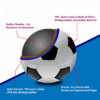The Growing Demand for Quality Sports Goods: A Wholesaler’s Perspective
The sports industry is booming, and with it, the demand for high-quality sports equipment and accessories is on the rise. As a sports goods wholesaler, staying ahead of the curve and meeting the diverse needs of retailers, gyms, schools, and sports clubs is crucial. With trends constantly evolving, it’s essential for wholesalers to adapt to the ever-changing market to maintain strong relationships with suppliers and customers alike.
The Changing Landscape of Sports Goods
In recent years, the sports industry has experienced significant growth. More people are prioritizing fitness, taking up new sports, and participating in recreational activities. From footballs to yoga mats, tennis rackets to weightlifting gear, the variety of products demanded by consumers has increased exponentially.
Sports enthusiasts are now looking for specialized products that cater to their unique needs, such as eco-friendly sports equipment, high-performance gear, and items that enhance training efficiency. This shift means wholesalers must diversify their product offerings and ensure that they have high-quality stock that meets the demands of a more knowledgeable, tech-savvy market.
Key Factors Driving Demand
- Health & Fitness Trends: The global movement towards healthier lifestyles and fitness is one of the main drivers of increased demand for sports goods. People of all ages are engaging in physical activities ranging from professional sports to casual home workouts.
- E-Commerce and Online Shopping: The convenience of online shopping has made it easier for customers to browse, compare, and purchase sports goods in bulk. Retailers often rely on wholesalers to provide competitive prices and timely deliveries, which is where building strong, reliable relationships with online and offline customers is vital.
- Technological Advancements: New technologies, such as smart sports equipment (e.g., wearables, fitness trackers, and sensors), are becoming more popular. Wholesalers need to stay updated on these innovations to stock products that meet the needs of customers looking for cutting-edge equipment.
- Sustainability: Consumers today are more conscious of their environmental impact. This has led to a rise in demand for eco-friendly and sustainable products, such as biodegradable tennis balls or recycled materials in sportswear. Wholesalers must ensure that their suppliers align with these values to meet customer expectations.
Building Strong Relationships with Retailers
One of the biggest challenges faced by sports goods wholesalers is maintaining healthy, long-term relationships with retailers. In order to do so, wholesalers need to focus on providing value beyond just price. This includes offering reliable supply chains, efficient logistics, customer support, and, most importantly, a diverse and high-quality product range.
The Role of Wholesale Sports Goods in Local Communities
As a sports goods wholesaler, you play a vital role in supporting local sports teams, schools, and recreational centers. By providing these organizations with affordable, top-notch equipment, you are helping to foster a culture of active living and well-being within communities.
Moreover, by sourcing and supplying products that cater to various levels of athletes—whether it’s beginner gear for schools or advanced equipment for competitive clubs—you are contributing to the development of local talent and sporting excellence.
Navigating Challenges in the Sports Goods Wholesale Business
While the demand for sports equipment is strong, wholesalers face several challenges in the market. Fluctuating production costs, supply chain disruptions, and maintaining inventory levels can all impact a wholesaler’s ability to deliver on time. Moreover, with the fast-paced nature of the sports industry, staying updated on emerging trends and new products is a constant balancing act.
To mitigate these challenges, wholesalers need to implement efficient inventory management systems, develop strong relationships with manufacturers, and be proactive in identifying and responding to market trends.
Conclusion
The sports goods wholesale business continues to evolve, driven by changing consumer demands, technological innovations, and growing global interest in fitness and recreational activities. By focusing on high-quality products, building strong relationships with retailers, and adapting to market trends, wholesalers can thrive in this dynamic industry. Whether you’re serving local teams or global e-commerce giants, being a reliable supplier of top-tier sports equipment is key to success in the competitive world of sports goods wholesale.
If you’re a wholesaler looking to expand your product offering or a retailer in need of reliable suppliers, the future looks bright for those who stay ahead of the game in this thriving industry.




